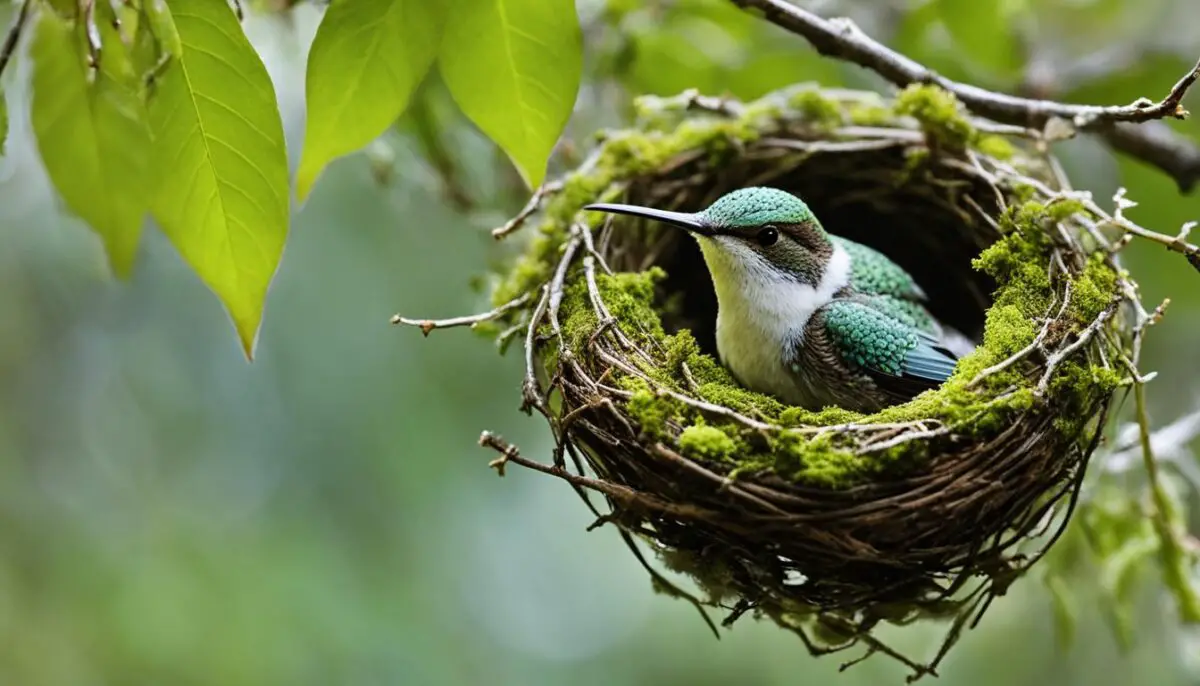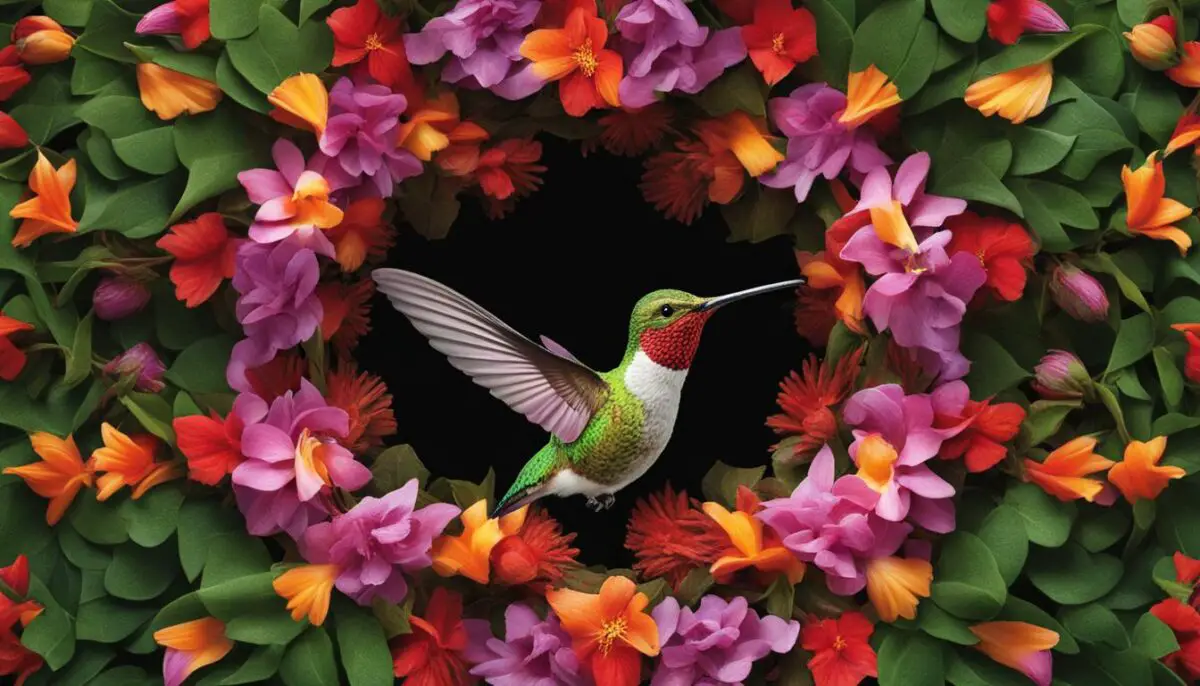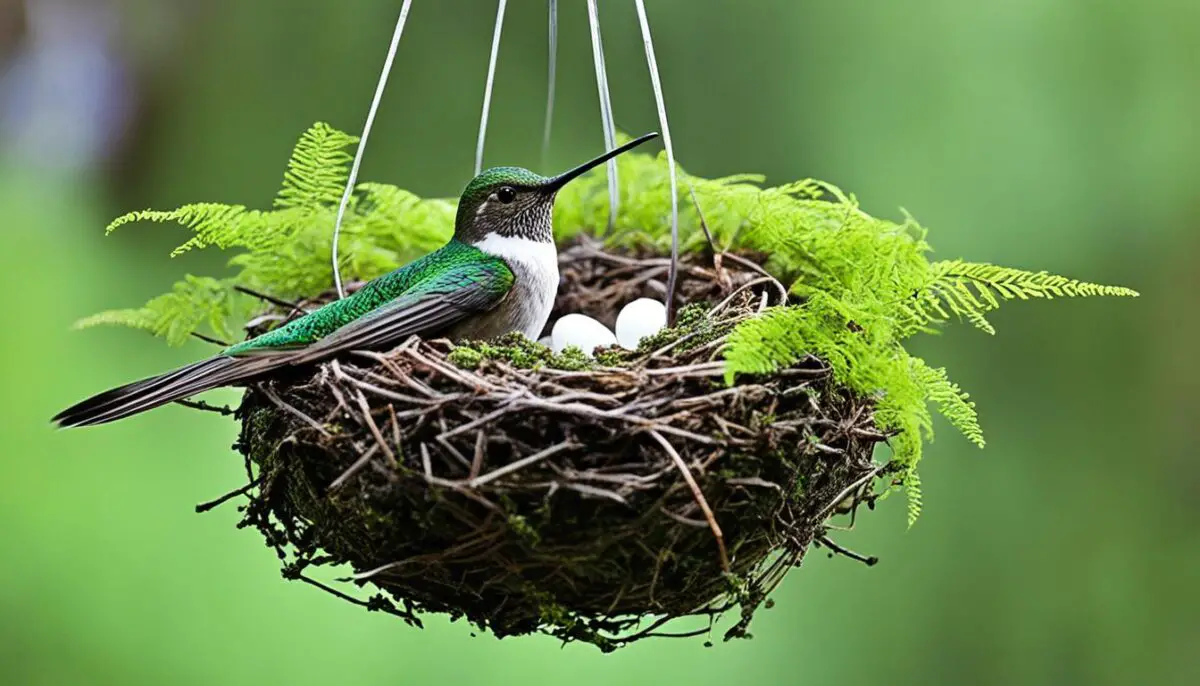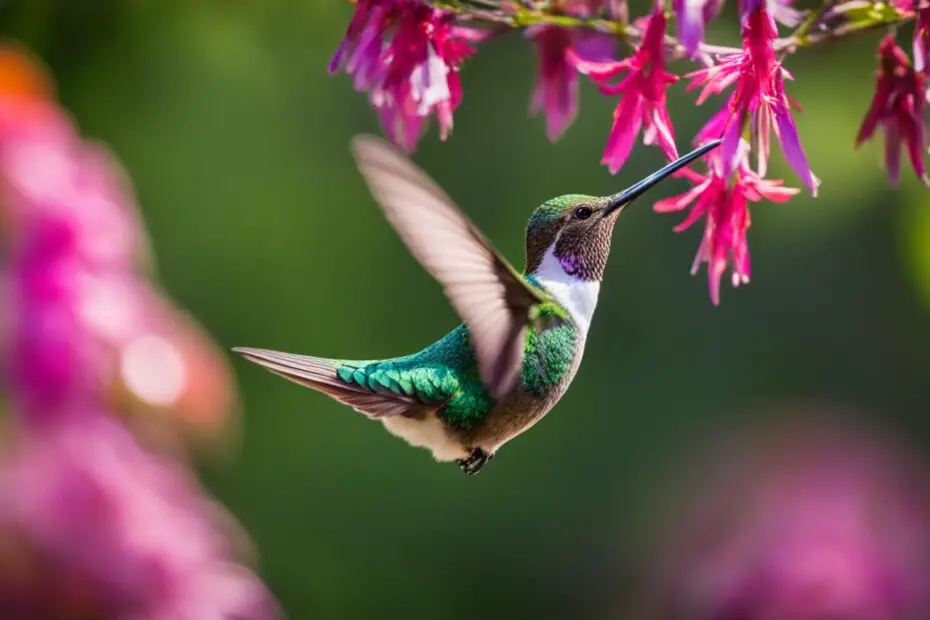Hummingbirds are captivating creatures that not only lay eggs but also exhibit fascinating nesting habits. Understanding their breeding behaviors provides valuable insights into their unique lifestyles. Let’s delve into the intriguing world of hummingbird nests and discover more about these remarkable avian wonders.
When it comes to nesting, hummingbirds meticulously select shrubs as their preferred sites and fashion their nests using delicate materials like spider silk and plant fibers. To provide camouflage, these nests are skillfully adorned with lichen and moss, blending seamlessly with their surroundings.
Hummingbird eggs are as tiny as coffee beans, and their incubation period ranges from 15 to 20 days. During this time, the mother hummingbird diligently cares for her nestlings, nourishing them with a diet of regurgitated insects and nectar. It’s truly a testament to the devotion and care that hummingbirds possess as parents.
Let’s explore more fascinating aspects of hummingbird nesting habits, from the construction of their nests to the challenges they face in protecting their eggs and nestlings.
Hummingbird Nesting Habits
Different species of hummingbirds have unique nesting habits that are intricately linked to their survival and breeding cycles. These fascinating birds carefully choose their nesting sites and construct their nests with precision.
Hummingbird Nesting Season
Hummingbirds coincide their nesting season with the flowering of specific plants. This timing ensures an abundant supply of nectar and insects for their growing nestlings. For example, Ruby-throated Hummingbirds, found in North America, begin nesting around May, coinciding with the blooming of the wild Flowering Columbine.
Hummingbird Nest Construction
Female hummingbirds are responsible for nest construction. They use an array of materials such as spider silk, thistles, and dandelions to weave their delicate nests. The use of spider silk ensures the nests’ flexibility and durability. These tiny birds build their nests on thin branches, roadside cables, and even clotheslines, providing protection from predators.
Hummingbird Nesting Sites
Hummingbirds carefully select their nesting sites to safeguard their eggs and nestlings. They often choose well-hidden locations, blending their nests with the surrounding environment. This camouflage protects their offspring from potential threats. While each species has its own preferences, hummingbirds commonly nest on thin branches, usually near a source of food.
Observing the intricate construction and selection of nesting sites by hummingbirds provides an insight into their remarkable survival strategies. These tiny birds showcase their resourcefulness and adaptation to create safe and nurturing environments for their young.
Hummingbird Egg Incubation
Hummingbird eggs are incredibly small, usually about the same size as a coffee bean. In fact, the Bee Hummingbird, the smallest bird species, lays eggs that are even smaller, approximately the size of a pea (source: Cornell Lab of Ornithology). Female hummingbirds take on the responsibility of incubating their eggs, carefully brooding and caring for their nestlings during this critical period.
The incubation period for hummingbird eggs typically lasts about 15 to 20 days. Throughout this time, the mother hummingbird diligently keeps her eggs warm, providing the optimal conditions for their development. During incubation, the mother also feeds herself and her nestlings, ensuring they receive the necessary nutrients to thrive.
“Hummingbird eggs are truly remarkable. Despite their diminutive size, they hold the promise of new life and the continuation of this incredible bird species.” – Expert Birdwatcher
As the eggs incubate, the mother hummingbird regurgitates insects and nectar to feed the hatchlings. This diet is rich in protein and sugars, supporting their growth and development. The hatchlings gain weight rapidly, expanding at a rate of approximately 0.01 ounces per day (source: National Wildlife Federation).
After about a week of incubation, the hummingbird nestlings start to show visible signs of growth and change. They become more feathered, able to regulate their own body temperature, and gradually open their eyes, providing a fascinating glimpse into their emerging world. These newborns also begin to engage in early wing movements, preparing for the day when they will take flight and explore the world beyond the nest.
Fascinating Facts About Hummingbird Egg Incubation:
- Hummingbird eggs are some of the smallest eggs of any bird species, with sizes comparable to a coffee bean.
- The incubation period for hummingbird eggs usually lasts around 15 to 20 days.
- Incubation is primarily the responsibility of the female hummingbird.
- During incubation, the mother hummingbird feeds on insects and nectar to nourish herself and her nestlings.
- The mother hummingbird’s diet aids in the rapid growth of the hatchlings, who gain approximately 0.01 ounces per day.

| Hummingbird | Egg Size | Incubation Period |
|---|---|---|
| Ruby-throated Hummingbird | Approximately the size of a coffee bean | 15-18 days |
| Anna’s Hummingbird | Approximately the size of a coffee bean | 15-19 days |
| Costa’s Hummingbird | Approximately the size of a coffee bean | 16-18 days |
Hummingbird Nest Camouflage and Predators
Hummingbird nests are masterfully camouflaged to protect them from their numerous predators. These tiny avian architects create nests that blend seamlessly with their surroundings, making them appear as inconspicuous mottled lumps. The intricate camouflage allows these delicate structures to remain hidden from potential threats.
Various animals pose risks to hummingbird nests, including jays, crows, woodpeckers, snakes, squirrels, and mice. These cunning predators exploit the nests to feast on both the eggs and the vulnerable hatchlings. Despite their small size, hummingbirds are not immune to predation. Kestrels and Merlins, in particular, target nesting hummingbirds, with females being particularly vulnerable.
Once the nestlings fledge and leave the relative safety of their nests, they become exposed to a wider array of potential predators. Small raptors, cats, and other opportunistic animals can pose serious threats to these young hummingbirds as they embark on their early flight attempts.

Predators of Hummingbird Nests:
| Nest Predators | Threats |
|---|---|
| Jays | Feast on eggs and nestlings |
| Crows | Opportunistic nest predators |
| Woodpeckers | Peck to access nest contents |
| Snakes | Predators of eggs and nestlings |
| Squirrels | Seek out and devour eggs and nestlings |
| Mice | Threaten nests, especially during construction |
| Kestrels | Predators of nesting hummingbirds, particularly females |
| Merlins | Target nesting hummingbirds |
| Small Raptors | Threaten fledgling hummingbirds once they leave the nest |
| Cats | Capture and prey on young hummingbirds |
| Other Animals | Varying degrees of predation risk |
Facts About Hummingbirds and Their Nests
Hummingbirds are not only known for their vibrant colors and incredible flight abilities, but also for their unique nest-building behaviors. Let’s explore some fascinating facts about the materials they use, their nest reuse habits, and the various types of hummingbird nests.
“Hummingbirds are nature’s engineers, creating intricate nests with remarkable precision.”
Hummingbird Nest Materials
When it comes to building their nests, hummingbirds use a variety of materials found in their surroundings. These include:
- Spider silk: Hummingbirds often use spider silk to strengthen the structure of their nests.
- Soft plant matter: They use soft plant fibers, such as moss and lichen, to provide a cozy lining for their nests.
- Feathers: Hummingbirds incorporate feathers into their nests for added insulation and comfort.
- Fuzzy materials: Some hummingbirds use fuzzy materials, such as seed fluff or cotton, to create a soft nest environment.
Each species of hummingbird has its own preference for the materials used in nest construction. These materials not only provide strength and insulation but also help the nests blend harmoniously with their surroundings.
Hummingbird Nest Reuse
Hummingbirds exhibit an interesting behavior of reusing their nests. After successfully raising their young and once the nesting season is over, they may return to the same nest site the following year. However, they do not reuse the nest materials. Instead, they refurbish the nest with fresh materials, ensuring its stability and hygiene.
This behavior of nest reuse allows hummingbirds to save time and energy during the nesting process, which is crucial for their survival in their often challenging habitats.
Types of Hummingbird Nests
Hummingbirds create a variety of nest structures depending on their species and environmental conditions. Here are a few examples:
| Hummingbird Species | Nest Structure |
|---|---|
 |
They build their nests under rocky overhangs, providing protection from predators and strong winds. |
| Calliope Hummingbird | The Calliope Hummingbird uses a dead pinecone as the base of its nest, creating a unique and sturdy structure. |
| Anna’s Hummingbird | Anna’s Hummingbirds build their nests in various locations like shrubs, trees, or even on man-made structures like clotheslines or wire fences. |
These remarkable adaptations showcase the versatility and resourcefulness of hummingbirds, allowing them to thrive in different environments and habitats.
Now that we’ve explored the fascinating facts about hummingbird nest materials, reuse habits, and types of nests, let’s delve deeper into the nesting seasons of different hummingbird species.
Hummingbird Nesting Season by Species
The nesting season for hummingbirds varies among different species. Understanding the timing of hummingbird nesting is crucial when observing and appreciating these beautiful creatures in their natural habitats. Let’s explore the nesting seasons of several hummingbird species.
Ruby-throated Hummingbirds
Ruby-throated Hummingbirds, found in North America, begin their nesting season in May. As the flowering of various plants occurs during this time, these hummingbirds choose their nesting sites. The availability of nectar-rich flowers provides them with a reliable food source for their young.
Anna’s Hummingbirds
Anna’s Hummingbirds have a unique nesting season that takes place during the wet winter months. These hearty hummingbirds reside along the Pacific coast, where milder climates and an abundance of coastal flowers allow them to breed and raise their young.
Costa’s Hummingbirds
The nesting season for Costa’s Hummingbirds starts in early spring. These incredible birds, known for their striking purple-blue throat feathers, build their nests in the desert regions of the southwestern United States. Their breeding cycle aligns with the blooming of desert wildflowers.
Broad-tailed Hummingbirds
Broad-tailed Hummingbirds arrive in North America in late winter to early spring, marking the beginning of their nesting season. They are specifically adapted to withstand cooler temperatures and breed in mountainous regions. The availability of nectar from early spring flowering plants supports their reproductive success.
Each hummingbird species has specific nesting preferences, from the timing of their nesting season to the types of nesting sites they choose. Understanding these nuances helps us appreciate the diversity and beauty of hummingbirds and allows us to create favorable habitats to support their survival.

| Hummingbird Species | Nesting Season |
|---|---|
| Ruby-throated Hummingbirds | May |
| Anna’s Hummingbirds | Wet winter months |
| Costa’s Hummingbirds | Early spring |
| Broad-tailed Hummingbirds | Late winter to early spring |
Attracting Hummingbirds to Your Yard
If you want to attract hummingbirds to your yard, there are a few steps you can take.
- Provide fresh nectar in feeders
- Plant hummingbird-friendly plants
- Place feeders and plants strategically
- Maintain feeder cleanliness
Provide fresh nectar in feeders
Hummingbirds rely on nectar as their primary food source, so offering a steady supply of fresh nectar is essential. Use hummingbird feeders specifically designed to hold nectar, and fill them with a solution of four parts water to one part white granulated sugar. Avoid using red dye or artificial sweeteners, as they can be harmful to hummingbirds.
Plant hummingbird-friendly plants
Another way to attract hummingbirds is by planting a variety of hummingbird-friendly plants in your yard. These plants provide additional sources of nectar, as well as natural perches and hiding spots for the birds. Some popular hummingbird-friendly plants include:
- Autumn sage
- Desert honeysuckle
- Penstemon
By incorporating these plants into your landscape, you can create a vibrant and enticing habitat for hummingbirds.
Place feeders and plants strategically
When positioning your hummingbird feeders and plants, consider their proximity to windows and other features of your yard. Placing them near windows allows for easy observation of these beautiful birds. Additionally, positioning feeders and plants within the landscape, such as near trees or shrubs, provides a sense of shelter and natural habitat for hummingbirds.
Maintain feeder cleanliness
Regularly clean and refill your hummingbird feeders to ensure the health and well-being of the hummingbirds. The nectar can spoil quickly in warm weather, so clean the feeders every few days and refill them with fresh solution. Use a solution of one part white vinegar to four parts water for cleaning, and rinse thoroughly before refilling.
By following these steps, you can create an inviting environment that attracts hummingbirds to your yard, allowing you to enjoy the beauty and grace of these incredible creatures.
| Hummingbird-friendly Plants | Plant Description |
|---|---|
| Autumn sage (Salvia greggii) | Produces vibrant red, pink, or purple tubular flowers; blooms from late spring to fall; attracts hummingbirds with its abundant nectar. |
| Desert honeysuckle (Anisacanthus quadrifidus) | Features bright orange-red or coral tubular flowers; blooms from summer to fall; a favorite of hummingbirds for its nectar. |
| Penstemon (Penstemon spp.) | Comes in various colors, including red, pink, purple, and white; produces tubular flowers that hummingbirds find irresistible; blooms from late spring to summer. |
Conclusion
Hummingbirds are truly remarkable creatures with fascinating nesting habits. From constructing well-camouflaged nests to caring for their nestlings, these tiny birds showcase incredible parenting skills. Using materials such as spider silk and plant fibers, hummingbirds create cozy nests where their eggs will incubate for about 15 to 20 days.
Once the eggs hatch, the mother hummingbird diligently feeds her young with a nutritious blend of regurgitated insects and sweet nectar. This nurturing continues until the nestlings are ready to venture out on their own. Understanding the nesting habits and timings of different hummingbird species is crucial in appreciating and supporting their populations.
By providing a suitable habitat in your yard, complete with hummingbird-friendly plants and well-placed feeders, you can attract these incredible birds. As you witness their nesting behavior up close, you’ll be captivated by the intricacy and dedication they put into raising their young. So, create a welcoming environment for hummingbirds, and enjoy the privilege of observing their remarkable nesting journey.
FAQ
Do hummingbirds lay eggs?
Yes, hummingbirds do lay eggs. They are fascinating creatures that not only lay eggs but also build nests and raise their young.
What are the nesting habits of hummingbirds?
Hummingbirds choose nesting sites in shrubs and construct their tiny nests using spider silk and plant fibers. They build their nests on thin branches, roadside cables, and even clotheslines.
How long is the incubation period for hummingbird eggs?
The incubation period for hummingbird eggs is around 15 to 20 days. During this time, the female hummingbird broods and cares for her eggs.
How do hummingbird nests camouflage themselves?
Hummingbird nests are well-camouflaged with lichen and moss, blending in with their surroundings. They appear as small, pale, mottled lumps on thin branches to protect them from predators.
What are the predators of hummingbird nests?
Many animals, such as jays, crows, woodpeckers, snakes, squirrels, and mice, prey on hummingbird nests for their eggs and nestlings. Some raptors, like kestrels and Merlins, may also prey on nesting hummingbirds.
What materials do hummingbirds use to build their nests?
Hummingbirds use various materials, including spider silk, soft plant matter, feathers, and fuzzy materials, to construct their nests. Some hummingbirds even steal nesting materials from other hummingbirds.
When is the nesting season for different hummingbird species?
The nesting season varies by species. Ruby-throated Hummingbirds nest in North America starting in May, Anna’s Hummingbirds nest during the wet winter months, Costa’s Hummingbirds nest in early spring, and Broad-tailed Hummingbirds arrive in late winter to early spring.
How can I attract hummingbirds to my yard?
To attract hummingbirds, provide fresh nectar in feeders and plant hummingbird-friendly plants such as autumn sage, desert honeysuckle, and penstemon. Place feeders and plants near windows or within the landscape and ensure they are placed in safe locations away from potential dangers.
What are some interesting facts about hummingbirds and their nests?
Hummingbird eggs are tiny, about the size of a coffee bean, and the mother hummingbird feeds the hatchlings regurgitated insects and nectar until they are ready to leave the nest. Hummingbirds often reuse the same nest site year after year but use fresh materials to refurbish the nest.
Can I observe and appreciate hummingbird nesting behavior in their natural habitats?
Yes, by understanding the nesting habits and timing of different hummingbird species, you can observe and appreciate them in their natural habitats. It’s important to respect their nesting sites and provide a suitable habitat for their survival.

